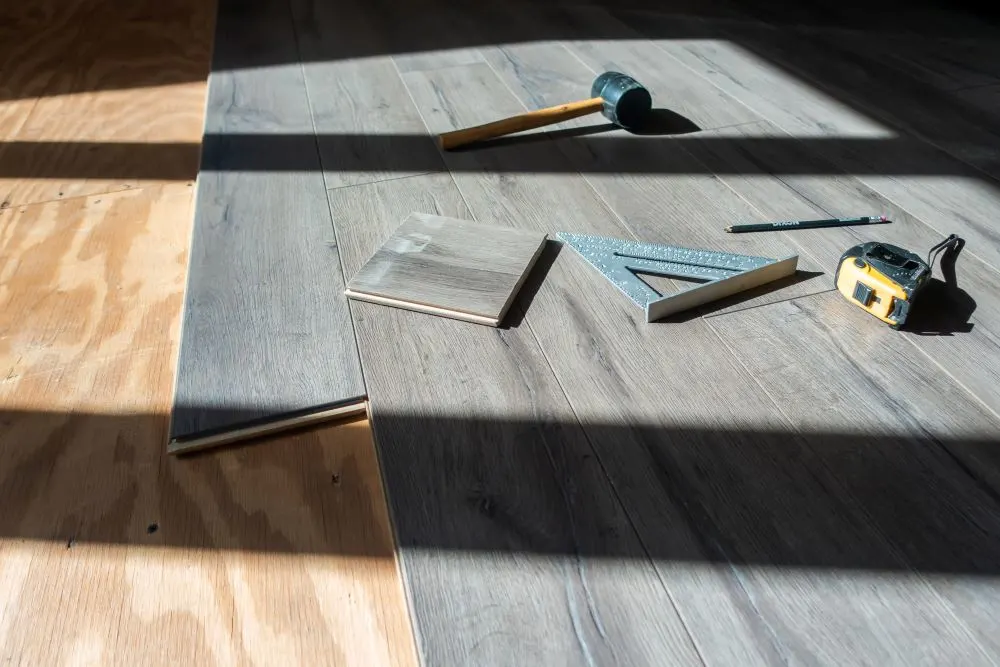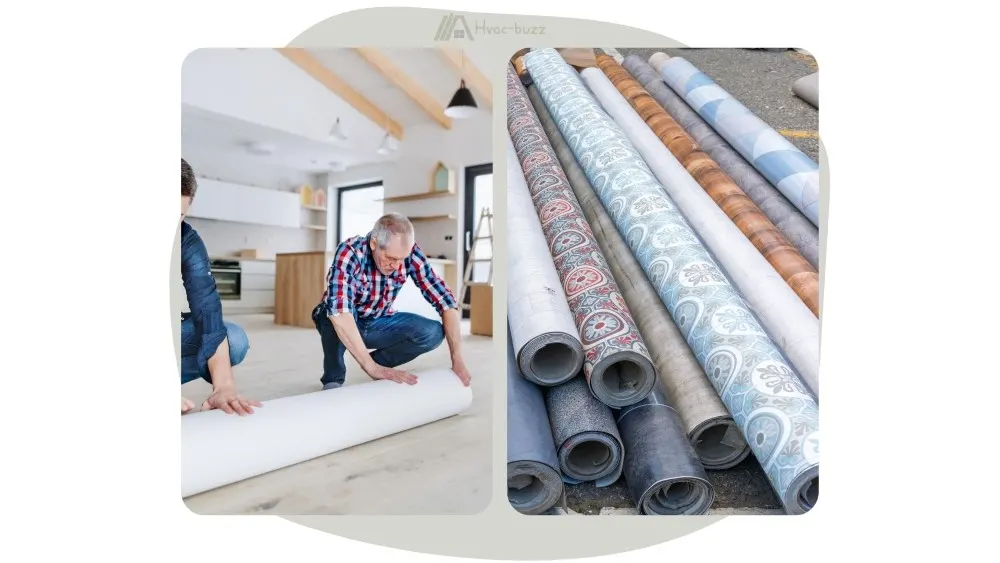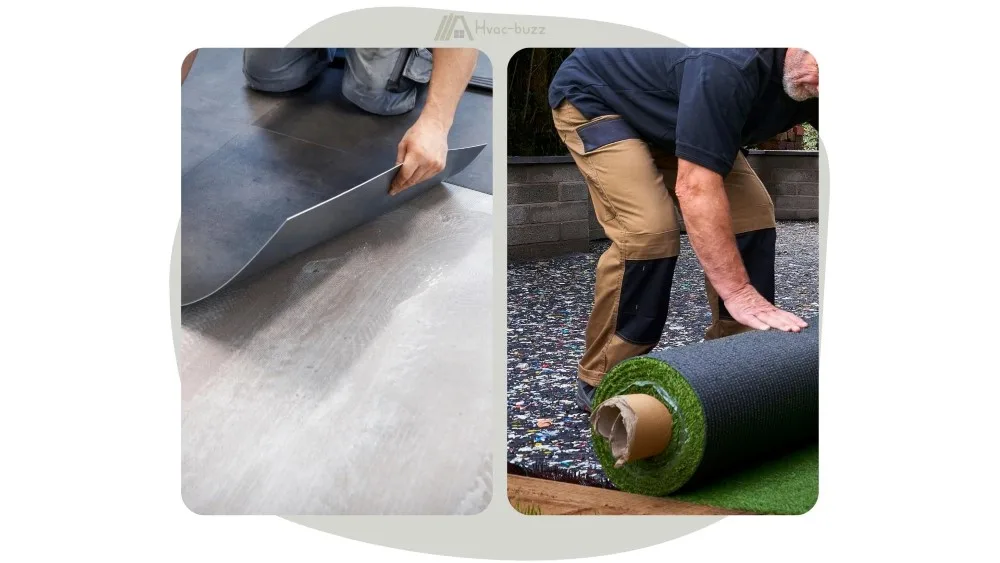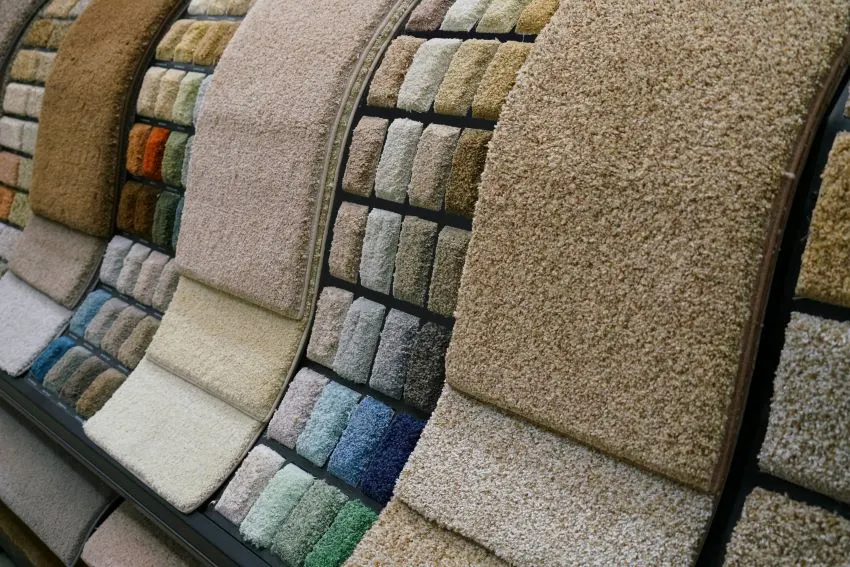Your floor can be uneven for many reasons: sloped subfloor (structurally sound level that is the foundation for flooring) or underlayment (smoothing level on top of the subfloor), pockmarked subfloor or underlayment, or old flooring. Solutions to this can get expensive and take a lot of time, so let’s look at flooring options that can cover uneven flooring.
1. Laminate Floating Floor
Laminate flooring is a combination of four layers that are compressed together:
- Base: balances the flooring, providing strength and preventing misshaping.
- Core: made of fiberboard and gives structure.
- Design: high-quality photograph printed on the core layer to create the look of wood, stone, tile, brick, or ceramic.
- Protective: transparent laminated topcoat to protect the flooring.
Laminate flooring is a floating floor. What this means is that, instead of attaching to the floor surface, the flooring clips into itself. This provides an even-looking layer that will disguise an uneven floor in your basement.
The only problem is that while the floor will look even, the subfloor will not be easily forgettable. You will likely hear cracking sounds as you walk over the uneven areas because the floor is sinking down to the true level. The cracking comes from the shifting connections between the laminate flooring sections.
You will be able to feel that the surface floor is not even (although a thicker laminate will help). And your laminate flooring will eventually begin to warp unless you prepare the floor with an underlayment. You can do this will concrete or cement, or you can use a self-leveling compound for an easy and quick fix.
Cost
Laminate flooring has always been a cheap option, and unlike when it was first used, it has a good finish and a high-quality look.
Laminate flooring is going to cost about $3-$8 per square foot. This is including materials and the cost of labor, so you may even find that it’s cheaper if you are installing it yourself. In fact, the flooring itself would only cost you approximately $0.68-$2.59 per square foot.
Maple, cherry, acacia, oak, and beech wood options are the cheaper options at about $0.68, while woods like walnut, elm, and hickory are slightly more.
This doesn’t include the cost of preparing your floor surface.
Pros
- Highly durable.
- Comes in a variety of aesthetic styles.
- Water-resistant and waterproof options.
- Possible to install in bathrooms and kitchens with the correct preparations.
- Scratch-resistant.
- Affordable.
- Designed to withstand areas of high traffic.
- Has a protective layer to prevent fading, staining, and scuffing.
- Easy to install.
- Is a floating floor and so can be installed over existing flooring.
- Low maintenance and easy to clean.
- Often has a good warranty.
Cons
- Can look artificial.
- Not as valuable for resale of house.
- Will have to replace damaged sections as cannot recondition.
- 48 hours acclimatization for the laminate.
- Need to prepare the floor.
- Lasts 20-30 years at most.
2. Floating Engineered Wood Flooring
Engineered wood flooring is comprised of a layer of your chosen wood over sheets (about 5 to 7) of plywood. This allows the authentic wood finish, feel, and look, but at a fraction of the cost of solid hardwood floors.
These floors are aesthetically pleasing and create a warm and elegant atmosphere in your home.
Engineered wood floors often have a floating installation method, which is why they are such an attractive option for uneven floors. Like the laminate flooring, floating engineered wood flooring clips into and attaches to itself and not the subfloor.

This means that you will get an even finish on the floor. And due to the strength of the wood, you will likely not feel the unevenness below the floor, and it is a very stable structure that will be resistant to bending and dipping.
Cost
Engineered wood flooring is priced around $6-$20 per square foot.
This price will depend on the veneer wood chosen and how thick it is, which can be 3/4″-5/16”. You will also need extra wood to complete small spaces and corners with custom-cut pieces.
You will also need to factor in the need for removing the old flooring if that is applicable, and you lack the time, patience, or desire to pull it up yourself.
Pros
- Durable.
- More affordable than hardwood.
- Classic wood floor look.
- Adds resale value to the house.
- Low maintenance in general.
- Variety of wooden veneers to choose from.
- Variety of design and patterning options (planks, tiles, etc.)
- Very long-lasting.
Cons
- Not the cheapest option.
- Noisy.
- Will require a sealed basement to protect from water.
- More complex installation.
- Must remove old flooring first.
- Requires re-finishing every several years (not often).
- Absorbs moisture.
- Prone to warping with moisture.
- Wooden layer (in some flooring) too thin to sand and will need to be replaced.
- Can become scratched and scuffed.
3. Floating Vinyl Flooring
Vinyl is similar to linoleum, but unlike its vintage counterpart, vinyl is entirely synthetic.
This flooring is designed to look like stone or wood with an image layer (similar to that of the laminated flooring) and has a protective layer to prevent scratching, while the core layer is water-resistant and prevents denting.
The floating installation will make your basement floor appear even, although you might feel the unevenness underfoot if the vinyl is not thick enough.
Because of all the flexing required from the joints, you may find that your vinyl flooring won’t last as long as it could. And this may also affect the longevity of the necessary sealing.
If you choose to glue down the vinyl, you might experience lifting over the uneven areas of the floor with time. You are also likely to use too much glue trying to get the tiles to stick, and this can result in overflow and sticky vinyl floors.
A bonus of vinyl is the ability to lay it over old flooring. With the extra layer, you may find that an uneven floor is almost completely disguised because there are two flooring levels working to do so.
Cost
Vinyl flooring can cost between $3 and $10 per square foot, depending on whether you are using sheets, planks, or tiles, and if you are opting for luxury products.
Pros
- Durable.
- Affordable.
- Variety of colors and patterns.
- Waterproof.
- Softer surface finish.
- Low maintenance.
- Can install over old floor.
Cons
- Can be prone to tears and scratching because of softer surface.
- No resale value added.
- Prone to fading with sunlight.
- Difficult to remove if glued.
- Can get sticky if not installed or cleaned properly.
4. Roll-out Flooring
There are two versions for this: vinyl sheeting or rubber rollers.
Vinyl Sheeting

This is actually a form of vinyl flooring that comes in a solid sheet that is custom cut to fit your floor and creates a continuous and seamless look.
This is a great option if you are going to install a laundry room in the basement as it is water-resistant.
It is a great and affordable option for a basement and creates lovely stone or wood looks. It is recommended to install it over a flat and smooth surface. It cannot even be put on stairs. However, you can get away with putting it over a sloped or pockmarked floor.
The solid sheet will help cover your uneven subfloor.
Just don’t use it for a subfloor that has speed bump-like structures. This would create strange bumping in the sheet and would not create an even or pleasing-looking floor. The sheeting needs to be able to lie flat. So, this won’t work well over your uneven basement floor unless you underlay or resurface it.
Rubber Rollers

Rubber rollers are sheets of rubber that are glued to the floor and create a seamless look.
This affordable flooring is excellent for gyms or playrooms as the floor is soft and resistant to wear. It is also water-resistant, so if you’re feeling adventurous, you can even out the basement floor and install an inflatable hot tub in the basement.
Because of the varying levels of thickness you can purchase, you will likely be able to disguise both the look and the feel of an uneven subfloor.
You may also encounter problems with the rollers if you have lumps on your floor, which would cause the rubber to sit weirdly on the floor.
Additionally, while the sheet format of the rubber may help because it is glued or taped down, you may have to deal with lifting over uneven surfaces.
Cost
The vinyl sheeting that is used for roll-out flooring is very inexpensive; you would likely pay $0.84-$1.36 per square foot.
Your rubber flooring could cost approximately $4-$12 per square foot.
Pros
Vinyl Sheeting
- Durable.
- Affordable.
- Water-resistant.
- Stain-resistant.
- Soft.
- Easy to install.
- Variety of styles and colors.
- Low maintenance.
Rubber Rollers
- Durable.
- Affordable.
- Cushioned.
- Easy installation in larger areas.
- Very water-resistant.
- Variety of styles and thicknesses.
- Creates seamless look.
Cons
Vinyl Sheeting
- Prone to discoloration.
- Prone to scratches and scuffing.
- Difficult to repair (replace whole sheet).
- Easily damaged by the subfloor.
Rubber Rollers
- Difficult to install.
- Slippery if wet.
- Strong rubber odor that takes time to fade.
- Adhesives used are a fire hazard.
- Must be kept away from sunlight.
5. Rigid Carpeting
Rigid carpets can create an even floor surface due to the stiff inflexibility, and they tend to hold their shape.
The type of carpet that would withstand uneven flooring is, unfortunately, not the cozy kind. It is the hard and synthetic kind, so just keep that in mind for what you are planning to do with the basement. For example, it would not be a great finish for a family room but would suffice for a home-gym area.

Depending on the carpet thickness and the padding, you shouldn’t be able to feel the uneven texture of the floor beneath. This is also assisted by the carpet baseboards that provide structure.
You might also be able to add extra padding in certain areas to help even out any sloping. Of course, you have limitations to how far you can go with this.
Cost
Carpeting installation will cost around $1-$8 per square foot (excluding labor).
Pros
- Durable.
- Cheap.
- Adds warmth to floors.
- Reduces noise.
- Resistant to mold and mildew.
- Stain-resistant (depends on material and color).
Cons
- Wear occurring in uneven areas might require replacing the carpet.
- Can attract bugs.
- Easily stained (depends on material and color).
- Difficult to clean.
- Prone to wear patterns in busy areas.
- Challenging to achieve professional finish DIY.
- Replacing of carpet will likely require replacing baseboards.
6. Pour New Layer of Concrete and Polish Finish
This flooring provides a smooth finish by a process of polishing concrete into a more refined finish. This will require some preparation involving cleaning and repairing the concrete to provide the best quality polish.
Before polishing the surface, you will need to grind the floor. Both use the same tool, just with different attachments. The grinding process will offer the opportunity to smooth out the basement floor (especially considering you will need to fill in any dips and holes). So it is a simple and effective method to evening out your basement floor.
You will not be able to detect that the subfloor is uneven, more so if you choose to use a concrete underlay. You can also polish any concrete floor, meaning that you can simply polish the subfloor.
Cost
To lay this type of flooring in your basement, it will cost you somewhere between $2 and $15 per square foot.
The higher prices come with more detailed and intricate designs, but the flooring is very cheap if you opt for something simple.
You will need to seal the floors, which will cost you, per square foot, somewhere between $0.20-$1.30 for the materials alone.
The expense will come in obtaining the tools. The grinder can cost approximately $460-$1,280 and the accessories about $1,015-$2,360.
- 12.5 amp power
- New guard system
- Four-stage dust intrusion seal
- High torque to handle sustained loads
- Three 4" alumunum back holders are included
- Skirt included to control water and dust
- 5/8-11 thread for connecting to most grinder/polishers
- accepts grinder/polishers with less than 2" (50mm) collar size
Last update on 2024-03-27 / Affiliate links / Images from Amazon Product Advertising API
Pros
- Durable.
- Affordable.
- Highly water-resistant.
- Mold-resistant.
- Extensive style and color options.
- Doesn’t require subfloor preparation.
- Resistant to scuffing and scratching.
- Prevent bugs, dust, and mites.
- Low maintenance.
- Adds to resale value.
- Variety of texture finishes (matte or varying shine).
- Can add polypropylene fibers to prevent cracking.
- Very long-lasting.
- Hypoallergenic.
- Helps increase light in room.
Cons
- Cold and hard.
- May crack with time and require filling and re-finishing.
- Can be slippery.
- Noisy.
- Zero shock-absorption.
- Prone to staining from acids and chemicals.
- Sealant requires 3-8 days for drying.
Address Moisture Problems Before Laying New Floor
It is crucial to deal with moisture issues in your basement, should you have any, before you put in the new floor. These problems, when hidden beneath a flooring cover, are still problems and will have to be fixed at some stage.
The concrete subfloor will be subject to more shifting with a higher moisture level in the basement. This will impact the longevity of any flooring you choose. It will also increase the risk of mold and mildew in your basement, which can damage and eat-away parts of the flooring and seals.
Water in your basement will also increase the risk of water causing damage to your flooring. Engineered wood and carpeting will be badly damaged and cause rotting and warping. Laminate flooring can swell, and the layers can split and peel.
The bottom line is that moisture in your basement is never a good thing and should be addressed.
Flooring Options That Will NOT Work
If the flooring options mentioned above are not what you are looking for, it might be helpful to know about the options that will not work, so you can avoid these in your quest for the perfect solution to your problem.
Traditional Hardwood Flooring
Hardwood flooring needs to be installed over a flat subfloor. While nothing may be noticeable at first, if your subfloor is uneven, you are going to encounter problems.
Your expensive and gorgeous hardwood will be stressed by the uneven subfloor, which will lead to creaking, cracking, damage, bending, and may eventually snap. Considering this flooring technically has the ability to last for decades, this will be a costly and disappointing problem to fix.
This is because solid wood floors lack flexibility. Your wooden planks or tiles cannot flex over the floor when the surface is not smooth.
Tiles
Tiles require a smooth and level floor surface. They adhere to the surface, and if the subfloor or underlayment is uneven, your tiles will shift and flex as you walk over them.
As they are unbalanced by the floor beneath, they will end up cracking and will likely lift as they are broken off and separated from the floor because the adhesion layer cannot endure the movement.
Your grouting will also crack and break as the shifting occurs.
With all the cracking and breaking of the tiles and grout, you will have to pull up the broken tiles and replace them, and you might end up having to re-do the entire floor before long.
(Note: there are more complex methods you can use to tile uneven flooring, but you will not be able to hide that your floor is uneven and your tiles will not look uniform and seamless.)
Glue-down Carpet
Glue-down carpet is installed by gluing the carpet onto the floor surface beneath. Not only is this type of carpet often thin, which will not provide sufficient coverage for the look of uneven flooring, but you will feel every lump and bump in your basement floor.
Additionally, due to the gluing, you will need a flush contact or the carpet will not secure properly and will warp and lift.
Consider Evening out the Floor
All of the flooring options we discussed here can only benefit from an even subfloor. For the best results of any of the flooring methods, it is recommended that you install them on a flat and even surface.
Additional Concrete Layer
You could always just add a layer of concrete over the uneven floor and level the area out.
Should you want to polish the top, as mentioned above, that is a good option, but you could also use the layer as an underlayment and put your desired flooring atop it.
You might lose a few inches of floor-to-ceiling height. This shouldn’t be a problem as long as you can still comply with the regulations in the International Residential Code Section R305.1, which require a minimum ceiling height of 7 ft for a habitable area. The minimum requirement is 6 ft 8” for any variation of bathroom or toilet rooms, and laundry rooms.
The cost of this depends on the materials and quantities you need.
Self-leveling Compounds
You can use these compounds (such as SAVOGRAN Floor Leveler (amazon link)) to fill holes and dips in your subfloor. If you have both dips and ridges, you will need to do a two-step underlayment. First, you will fill the dips or holes. You are then filling the entire floor and sanding down the ridges in the compound to make everything even.
The cost of this will depend on the type of leveling compound you use, the quantity of product you need, and the tools you need. Likely this will be limited to putty knife and sandpaper, both of which can be found on Amazon.
Removing Old Flooring
Another reason why your floor may be uneven is that there are too many layers of flooring. Laminate flooring can be installed over pre-existing flooring, and if there are several layers to your floor, you might find that removing these old installations will leave you with a clean slate.
Unless you do this yourself, you might expect to pay $0.50-$3.00 (can include disposal of old flooring).
Re-laying Your Basement Foundation
This is a big undertaking, yes, but will ultimately give you the best results. It will allow you to address water problems and create a smooth surface from the very foundations of your floor.
This will likely cost upward of $582 for the new floor installation alone.
Sources
https://www.flooringamerica.com/blog/what-is-laminate-made-of
https://homeguide.com/costs/cost-to-install-laminate-flooring
https://www.flooringstores.com/blog/what-is-laminate-flooring/
https://www.ambiencehardwoodflooring.co.uk/wood-flooring-guide/what-is-laminate-flooring/
https://homeguides.sfgate.com/install-laminate-flooring-uneven-surface-26628.html
https://www.bestlaminate.com/11-biggest-mistakes-when-installing-laminate-flooring/
https://www.angi.com/articles/how-much-should-my-new-floor-cost.htm
https://homeguide.com/costs/flooring-installation-cost
https://homeguide.com/costs/carpet-installation-cost#glue
https://homeguide.com/costs/polished-concrete-floor-cost
https://homeguide.com/costs/cost-to-finish-a-basement#breakdown
https://www.homeadvisor.com/cost/flooring/rubber-floor/
https://www.avalonflooring.com/ideas/blog/vinyl-sheet-flooring-pros-cons







